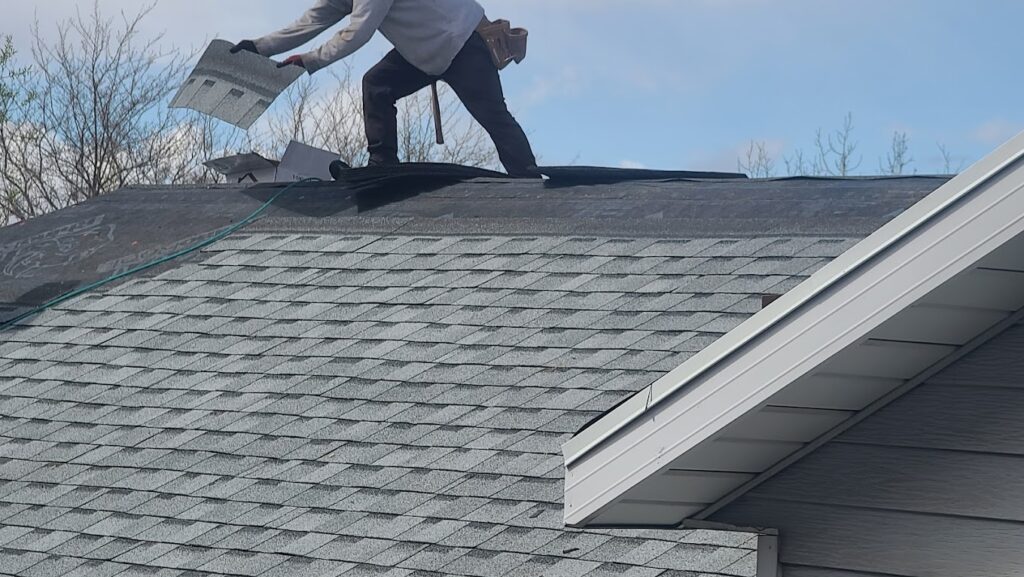
Planning to work on your roof this fall? Before you grab those tools and climb that ladder, let’s prioritize safety.
We’ll provide you with essential tips for a secure and accident-free roofing experience. From residential to commercial projects, the risks can be significant. That’s why we want to equip you with the knowledge and precautions necessary to protect yourself and others.
Here are some important safety tips for working on your roof.
Importance of Safety Precautions
You should always take necessary safety precautions when working on your roof to prevent accidents and injuries. Working at heights can be dangerous, so it’s crucial to undergo safety training to understand the risks involved and how to mitigate them.
Additionally, make sure to use the appropriate roofing equipment, such as ladders and safety harnesses, to ensure stability and minimize the chance of falls. Wearing personal protective equipment, such as hard hats, gloves, and non-slip footwear, is also essential for your safety.
Familiarize yourself with safety regulations and guidelines to ensure compliance and reduce the risk of accidents. By following these precautions, you can ensure a safer working environment for yourself and those around you.
Proper Use of Ladders When Working on Your Roof
When working on your roof, it’s important to understand and follow proper ladder usage to ensure your safety. Ladder safety should always be a top priority to prevent accidents and injuries.
Before using a ladder, inspect it thoroughly to make sure it’s in good condition. Check for any cracks, loose rungs, or other signs of damage.
Position the ladder on a stable surface, ensuring that it’s on level ground and that all four feet are firmly planted.
Make sure to choose a ladder with the appropriate weight capacity for your needs. Never exceed the weight limit specified by the manufacturer.
Lastly, maintain ladder stability by securing it at the top and bottom, and avoid overreaching or leaning to one side while on the ladder.
Roofing Fall Protection Equipment
Using proper fall protection equipment is essential for ensuring your safety while working on the roof.
Roofing harnesses, roof guardrails, roof anchors, and other roofing fall protection equipment are designed to prevent falls and reduce the risk of injury.
- Roofing harnesses are worn by workers and are connected to secure anchor points to prevent them from falling off the roof.
- Roof guardrails provide a physical barrier along the edge of the roof, preventing accidental falls.
- Roof anchors are attachment points that allow workers to secure themselves to the roof.
- Roof safety nets are installed below the roof to catch workers in case of a fall.
It’s important to use the appropriate fall protection equipment and ensure that it’s properly installed and inspected before starting any work on the roof.
Weather Considerations
For the safety of yourself and your crew, it’s important to consider the weather conditions before working on your roof. Here are some weather considerations to keep in mind when it comes to roofing:
- Rain: Working on a wet roof can be dangerous as it increases the risk of slipping and falling. It can also compromise the integrity of roofing materials, leading to leaks and damage.
- Wind: Strong winds can make it difficult to maintain balance and control while on the roof. They can also cause loose materials, such as shingles, to become dislodged, posing a safety hazard.
- Extreme temperatures: Extreme heat or cold can affect the performance of roofing materials and the effectiveness of roof repair techniques. It’s important to take appropriate precautions and consider the impact of temperature on your roofing project.
Before starting any roof maintenance, inspections, or repairs, make sure to assess the weather conditions and prioritize safety above all else. If the weather is unfavorable, it may be best to postpone the work until conditions improve.
Additionally, if your roof is in need of replacement, explore different roof replacement options that are suitable for your local climate and weather patterns.
Hiring Professional Help: Safety Tips for Working on Your Roof
To ensure the quality and reliability of the job, it’s essential to hire professional help for your roofing needs. Hiring experts has numerous benefits, including their expertise in the field and their ability to provide cost-effective solutions.
At A1 Roofing, we have the proper training and knowledge to handle any roofing project, ensuring that the work is done safely and correctly.
We also prioritize quality workmanship, paying attention to every detail and providing prompt and efficient service. By hiring our team of professionals, you can have peace of mind knowing that your roof will be in capable hands and that the job will be done to the highest standards.
We hope these safety tips for working on your roof can help prevent serious accidents and injuries. If you are in need of a roof repair or roof replacement, call our office today!
